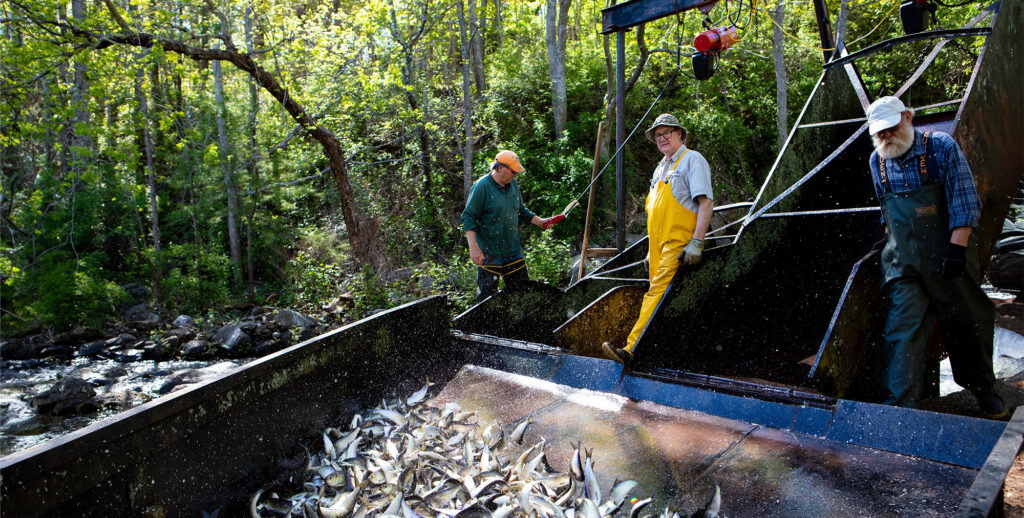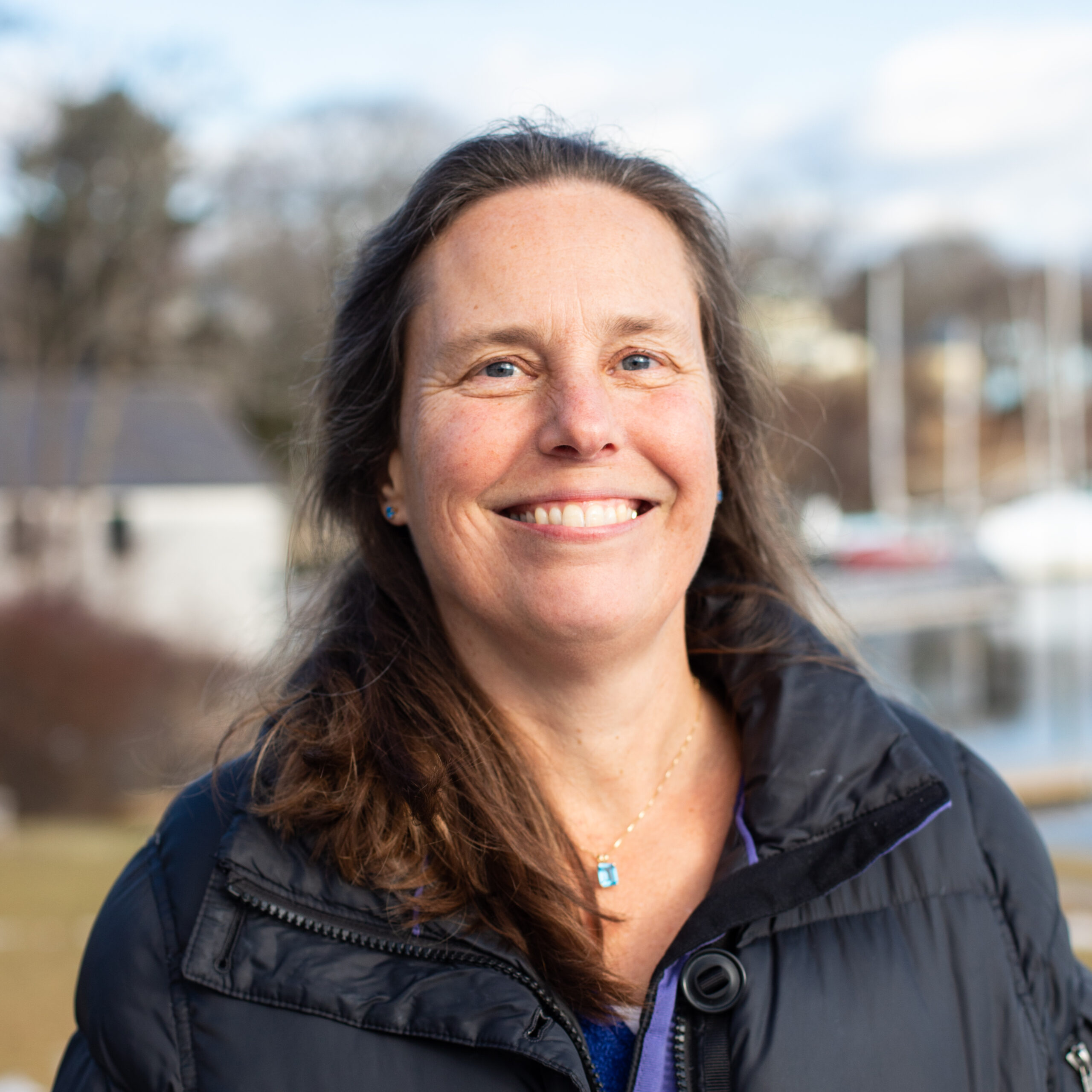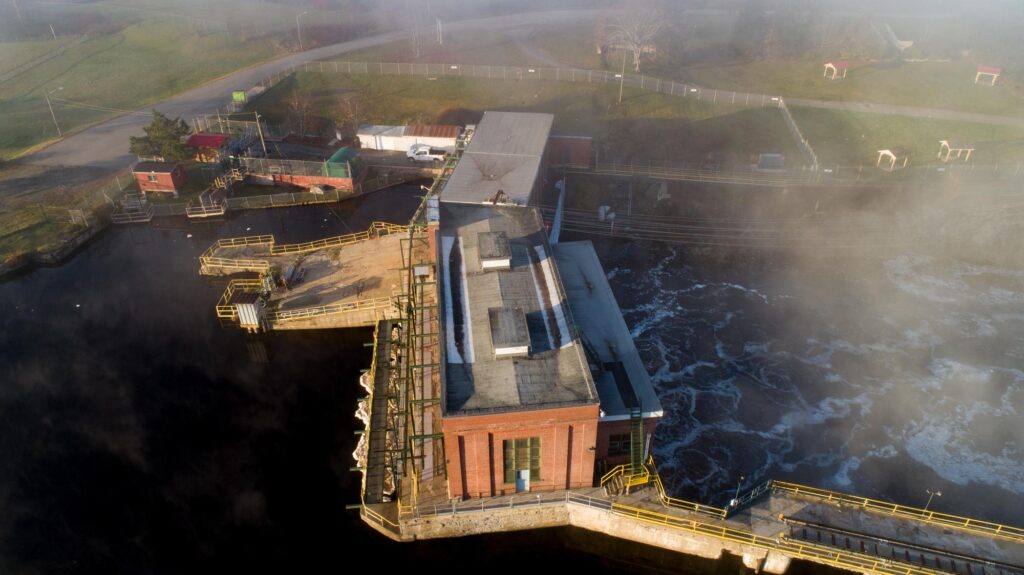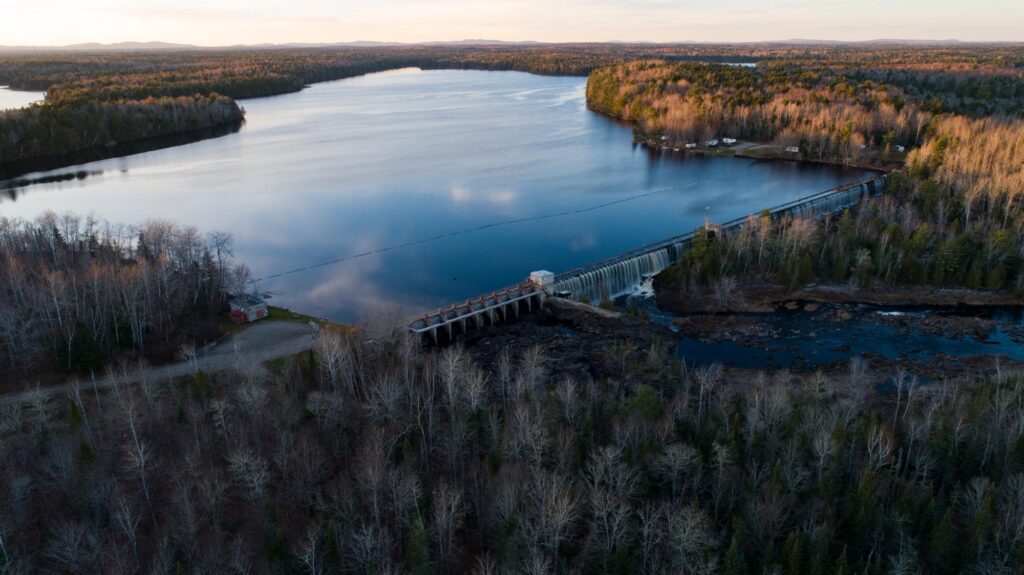
It’s not rocket science. “Take a freshwater fish, put it in salt water, and you’ve killed it. Take a marine fish, put it in fresh water, and you’ve killed it.”
So says Justin Stevens, a sea-run fish specialist at Maine Sea Grant while describing the wonder of sea-run—or diadromous—fish.

Like most organisms, fish require a strict regulation of salt within the body to function, so if a fish’s habitat is either too salty or not salty enough, it dies. Diadromous fish, however, challenge this conventional wisdom in that they thrive in both salt and fresh water. Stevens explains this superpower lies in the gills, where special cells detect the salinity of incoming water. The fish’s biology reacts accordingly, either by secreting salt out of the body or by bringing more in osmotically, allowing it to travel between salt and fresh water.
There are two sub-groups of diadromous fish: catadromous and anadromous.
Catadromous fish spend most of their lives in fresh water and migrate to salt water to reproduce. One of Maine’s most enigmatic species is the catadromous American eel which lives in fresh water for 20 years before leaving home for the Sargasso Sea, located off the Southeast United States. It is here that they spawn and die. The adolescent eels, known as elvers, then head to coasts all over the Atlantic Ocean, from Venezuela to Nova Scotia, where they work their way up rivers and streams, and the lifecycle repeats.
Most of Maine’s diadromous species are anadromous which means they spend their lives foraging at sea and run up rivers to reproduce, allowing their offspring to develop in a freshwater habitat, a more hospitable environment than the unforgiving open ocean.
Atlantic salmon, whose former abundance once represented an iconic and prolific fishery, are perhaps the most celebrated of Maine’s anadromous species. Salmon are known for both their incredible leaping abilities and their acute sense of direction. After feeding and growing in coastal waters, a mature salmon returns to fresh water when it’s time to reproduce. Remarkably, Atlantic salmon can navigate to their birthplace to spawn.
Following a similar migratory pattern is the Atlantic sturgeon, a prehistoric bottom dweller notable for its slow and immense growth. By the age of 60, an Atlantic sturgeon can grow to 14 feet and exceed 800 pounds.
Other anadromous species that run up Maine’s tributaries each spring include small fish like smelt (a deep-fried delicacy), shad (known for being a challenging catch for sport fishermen), and the tenacious
river herring, commonly referred to as the alewife. If you have the pleasure of witnessing the spectacle that is an alewife run, you’ll find it difficult to comprehend their vast numbers. They pack a river from bank to bank and appear infinite.
And yet today’s river herring population is likely 5% to 15% the size of its peak population a few hundred years ago, according to Anne Hayden, former senior fisheries program manager for Manomet and adjunct lecturer at Bowdoin College.

Hayden, who has spent much of her career focused on understanding fishery management in Maine, believes that diadromous fish—especially alewives—play a key role in the overall health of Maine’s ecosystems. Alewives, which Hayden refers to as “everyone’s lunch,” feed animals across many different habitats—including seals, foxes, birds of prey, microbes, humans (best served smoked or pickled), and of course, larger fish.
“If we want to restore coastal fisheries, we have to bring back the river herring,” Hayden asserts. “Herring are the base for the middle part of the food chain, and river herring have the potential to be abundant.”
Literally standing in the way of diadromous fish restoration are thousands of river blockages—mostly human-made structures like dams and culverts. If the fish are blocked from accessing their upstream mating grounds, they cannot spawn a new generation, drastically reducing overall populations.
In a February 2023 letter to the editor of the Portland Press Herald, Eugene McKenna of Bowdoinham describes the dilemma of the diadromous fish eloquently: “How would you like to have bank vault door between you and your honeymoon suite and not know the combination?”
McKenna wrote in opposition to Brookfield Renewable’s hydro-electric dam on the Kennebec River, but before hydroelectricity came to Maine, other human-made blockages throttled fish runs. First came the lumber mills and log jams dating back to early European settlers. Later came the paper mills.
In the mid-20th century, Great Northern Paper Company operated five hydro-powered mills impeding the Penobscot River watershed alone, a catastrophe for the river’s diadromous fish populations.
Thus unfolded the cautionary tale of the Atlantic salmon fishery, a story told in detail within the pages of Catherine Schmitt’s 2015 book, The President’s Salmon. Schmitt explains that the Penobscot River was once world-renowned for its salmon fishing, with the commercial fishery peaking in the 1880s. Less than a lifetime later, in 1947, only 40 salmon were commercially harvested on the river. The watershed’s fishery then closed—first commercially and soon thereafter recreationally. Atlantic salmon in the Gulf of Maine are now an endangered species. Schmitt writes:
“Today the fountain is dry. The flow has been altered… the route blocked by walls of concrete, the landscape made unfamiliar to the people, salmon, and others who had known it for generations. Salmon no longer migrate up the West Branch [of the Penobscot River], but their descendants still carry a longing for home that haunts the displaced.”
The deep bays and rivers of the Northeast were carved by giant sheets of ice—retreating glaciers gouging the land and forming the jagged Maine coast. Diadromous fish adapted to this landscape, working their way into inlets, rivers, and estuaries. About 13,000 years ago the Passamaquoddy Tribe’s ancestors relied on diadromous fish populations. Sea-run river herring is a foundational species, a fulcrum for both the ecosystem and human culture.
The connection between human and river herring, however, is not confined to a bygone era. The Passamaquoddy continue to advocate for the restoration of diadromous fish passage in their ancestral watershed, and other local efforts in Maine have gained traction in the last few decades as well.
Bailey Bowden is a champion of the river herring who traces his Maine ancestry back to 1632.

“I have been playing with alewives for the better part of 50 years at this point,” he proudly claims. He recalls his childhood interactions with the alewives of the Bagaduce watershed in Penobscot in the 1970s.
“It was a harbinger of springtime. Our parents would drop us off at the pond with a dipnet and a bucket. We’d collect the alewives, and the fishermen would trade us soda and candy bars for our buckets of fish. It was great fun for an eight-year-old.”
Bowden caught alewives every spring until the Department of Marine Resources closed the Bagaduce’s fishery in 2008 due to declining numbers. He immediately sprang into action to restore the alewife run and re-open the fishery, because to Bowden, the alewife harvest represents both an economic and cultural asset to his community.
The restoration required dedication and physical exertion, but Bowden would find many allies along the way. Players from Maine nonprofits have contributed to the restoration of the Bagaduce, Ciona Ulbrich of Maine Coast Heritage Trust among them. She applied for grants and communicated with water rights holders and landowners along the river. She facilitated relationships between towns and the engineering firms that deconstructed dams and culverts, diverted waterflow, and built new fishways.

Meanwhile, Bailey Bowden and his team of local volunteers continue to remove pesky beaver dams by hand to keep the rivers clear, and they work tirelessly to keep consistent data on the fish that return to ponds to spawn. Without years of data indicating a healthy alewife population, the Department of Marine Resources will not fully reopen the fishery.
“The numbers are showing an increase,” Ulbrich says with a smile. “You take out a dam, make the rivers passable, and they knock right on the door. It’s pretty amazing.”
The effort to improve access continues. The story of the Bagaduce watershed proves that diadromous fish can thrive in Maine’s modern watersheds. We just need to give them access to their honeymoon suite.
Jack Sullivan is photo editor of Island Journal and is Island Institute’s multimedia storyteller.






